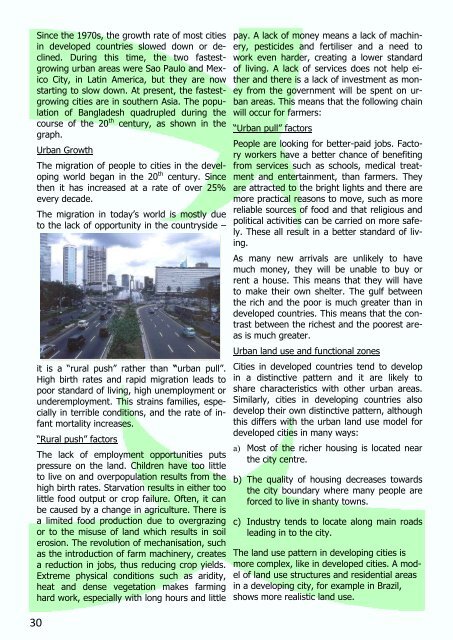habsgeographicalmar12
habsgeographicalmar12
habsgeographicalmar12
You also want an ePaper? Increase the reach of your titles
YUMPU automatically turns print PDFs into web optimized ePapers that Google loves.
Since the 1970s, the growth rate of most citiesin developed countries slowed down or declined.During this time, the two fastestgrowingurban areas were Sao Paulo and MexicoCity, in Latin America, but they are nowstarting to slow down. At present, the fastestgrowingcities are in southern Asia. The populationof Bangladesh quadrupled during thecourse of the 20 th century, as shown in thegraph.Urban GrowthThe migration of people to cities in the developingworld began in the 20 th century. Sincethen it has increased at a rate of over 25%every decade.The migration in today’s world is mostly dueto the lack of opportunity in the countryside –it is a “rural push” rather than “urban pull”.High birth rates and rapid migration leads topoor standard of living, high unemployment orunderemployment. This strains families, especiallyin terrible conditions, and the rate of infantmortality increases.“Rural push” factorsThe lack of employment opportunities putspressure on the land. Children have too littleto live on and overpopulation results from thehigh birth rates. Starvation results in either toolittle food output or crop failure. Often, it canbe caused by a change in agriculture. There isa limited food production due to overgrazingor to the misuse of land which results in soilerosion. The revolution of mechanisation, suchas the introduction of farm machinery, createsa reduction in jobs, thus reducing crop yields.Extreme physical conditions such as aridity,heat and dense vegetation makes farminghard work, especially with long hours and littlepay. A lack of money means a lack of machinery,pesticides and fertiliser and a need towork even harder, creating a lower standardof living. A lack of services does not help eitherand there is a lack of investment as moneyfrom the government will be spent on urbanareas. This means that the following chainwill occur for farmers:“Urban pull” factorsPeople are looking for better-paid jobs. Factoryworkers have a better chance of benefitingfrom services such as schools, medical treatmentand entertainment, than farmers. Theyare attracted to the bright lights and there aremore practical reasons to move, such as morereliable sources of food and that religious andpolitical activities can be carried on more safely.These all result in a better standard of living.As many new arrivals are unlikely to havemuch money, they will be unable to buy orrent a house. This means that they will haveto make their own shelter. The gulf betweenthe rich and the poor is much greater than indeveloped countries. This means that the contrastbetween the richest and the poorest areasis much greater.Urban land use and functional zonesCities in developed countries tend to developin a distinctive pattern and it are likely toshare characteristics with other urban areas.Similarly, cities in developing countries alsodevelop their own distinctive pattern, althoughthis differs with the urban land use model fordeveloped cities in many ways:a) Most of the richer housing is located nearthe city centre.b) The quality of housing decreases towardsthe city boundary where many people areforced to live in shanty towns.c) Industry tends to locate along main roadsleading in to the city.The land use pattern in developing cities ismore complex, like in developed cities. A modelof land use structures and residential areasin a developing city, for example in Brazil,shows more realistic land use.30


